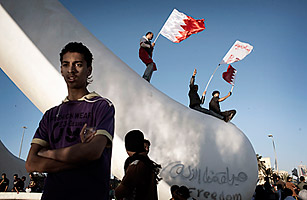
Bahraini protesters regain Pearl Square after a military crackdown
There's no need to panic.
Revolutions are messy affairs. They don't follow the easy logic of middle-school textbooks. Hostilities in the American Revolution broke out a year before the Declaration of Independence, and the Constitution was not ratified until nearly seven years after the decisive battle at Yorktown. In two years starting in 1974, Portugal went from neofascism to army rule to something like a communist putsch and then to liberal democracy, where, happily, it has stayed. (Along the way, events in that little country made the end of white rule in South Africa and Rhodesia inevitable. That's another thing about revolutions: their reverberations often surprise.) The Philippines got rid of Ferdinand Marcos in 1986 but is still groping toward a system of government that is both effective and democratic.
In the 10 weeks since demonstrations began in Tunisia, the Arab Middle East has been messiness personified. We have seen the relatively swift and peaceful ouster of the regime in Tunisia; an 18-day standoff marked by peaceful mass protests and sporadic regime resistance before the departure of President Hosni Mubarak in Egypt; demonstrations for constitutional reform combatted by deadly force, followed by negotiations in Bahrain; and most recently, the outbreak of violence bordering on civil war in Libya. And this catalog of the Arab world's democratic winter doesn't include the protests elsewhere, against everyone from a classic big man in Yemen to hereditary monarchs in Morocco and Jordan. So what can we learn from the region's revolutions — and those that went before them?
1. Provide, Provide, Provide
The key word for thinking about the Middle East today, says Eugene Rogan, director of the Middle East Center at Oxford University's St. Antony's College, is provision. Faced with the demands of a rapidly growing population of young people increasingly resentful of dynastic rule and increasingly linked to the outside world and one another by technology — and hence (and this is the key point) able to benchmark their situation against those elsewhere — regimes throughout the region have not done enough to provide sufficient jobs, education, housing, dignity. "Failure to provide," says Rogan, "is the most glaring source of tension. That's the constant."
Just as constant is the baseline demand of the protesters. It is quite simple: in the chant from the streets, Ishaab ureed isqat al-nizam, or "the people want the fall of the regime." But while those seeking reform in the Arab Middle East share much in the way of both grievance and objective, they also have significant differences. A region stretching from the Atlantic to the Indian Ocean is not homogeneous. Egypt has more than 80 million people; Bahrain around 1 million. Some nations, like Libya, have abundant oil and gas reserves; others, like Yemen, have little hydrocarbon wealth.
2. No Two Places Are the Same
No revolution is a perfect analogy for any other. Each nation in the Middle East has been colored in its own way by its history of colonial rule. Morocco, Algeria and Tunisia are francophone; Libya has good relations with Italy, its former colonial master; Jordan was once effectively a British protectorate. Egypt receives enormous quantities of U.S. aid, and the leaders of its armed forces have close ties with their counterparts in the Pentagon. That combination gives U.S. interests a salience in Egypt that they do not have in many other nations in the region.
As the revolutions play out, memories, resentments and social fractures specific to each country will shape their outcome. Egypt, for example, was long the natural leader of the Arab world. Humiliated by its decline in standing (this is a nation that once led the nonaligned movement), many Egyptians would doubtless like to see their country regain its place and revive the sense of cultural and political dynamism that elements within their society demonstrated after World War I and again after Gamal Nasser and his colleagues overturned the monarchy in 1952. In no other Arab nation is the desire to retrieve lost stature likely to be so significant.
Elsewhere, religion may shape what happens next. In Bahrain, the crowds have chanted "Not Sunni, not Shi'ite. Bahraini." But in a nation where a Sunni minority and royal family rule over a much poorer Shi'ite majority, sectarian issues could easily muddle demands for constitutional reform. Syria has its own fractures. The Assad family, which has ruled the country since 1970, is from the small Alawite Islamic sect — this in a Sunni-majority nation whose Islamists remember the way the regime bloodily crushed the Muslim Brotherhood in the 1980s. The government of Ali Abdullah Saleh in Yemen is threatened by two insurgencies — and the armed members of the local affiliate of al-Qaeda. Sudan is split between a Muslim, Arab north (whose members rule the country) and an African, Christian and oil-rich south that has just voted overwhelmingly to secede. Jordan is home to Palestinians who hail from west of the river and those whose origin is in the deserts to the east.